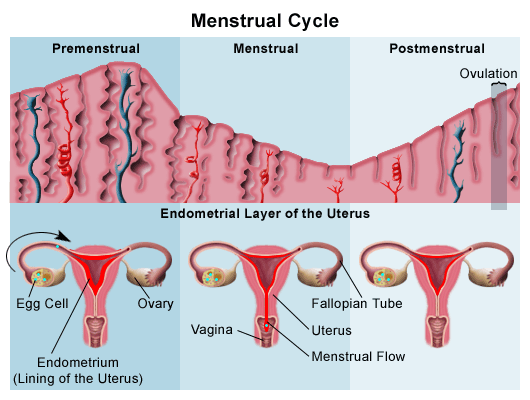 Aunt Flo, period, menstruation, menses or whatever else you might call, it is the monthly vaginal bleeding that girls and women experience. The first period is referred to as the menarche and this is a sign that the girl’s body is mature enough to conceive and carry a child. Usually,the menstrual flow lasts for 2-7 days and contrary to what many of you may think, most girls experience a flow that only amounts to about 30 milliliters. This is the equivalent of 2 tablespoons. The menstrual flow is a mixture of blood and tissue. To prevent leakage and staining of clothes, pads and tampons are worn to trap the blood.
Aunt Flo, period, menstruation, menses or whatever else you might call, it is the monthly vaginal bleeding that girls and women experience. The first period is referred to as the menarche and this is a sign that the girl’s body is mature enough to conceive and carry a child. Usually,the menstrual flow lasts for 2-7 days and contrary to what many of you may think, most girls experience a flow that only amounts to about 30 milliliters. This is the equivalent of 2 tablespoons. The menstrual flow is a mixture of blood and tissue. To prevent leakage and staining of clothes, pads and tampons are worn to trap the blood.
How Does Menstruation Happen?
Menstrual bleeding happens as a result of the body discharging blood and tissue that it no longer needs. Every month, your body builds up blood and tissue inside the uterus in anticipation for pregnancy. This becomes the lining that a fertilized egg is attached to if conception occurs. In most cases, fertilization does not occur when the lining sheds, which is what we call the period.
Let’s explain this process in detail. Women have two ovaries and each of these is home to thousands of eggs. Every month, an egg is released and travels down through one fallopian tube into the uterus which is the womb. If the egg is not fertilized by a sperm, the lining that is naturally developed in the uterus will not be required and it will shed, leading to a girl’s period. As mentioned, this occurs every month which means that once the period is over, the cycle will begin all over again. Two weeks after your period, this uterus lining should begin to develop and another egg will be released for fertilization.
What Is Menstrual Cycle?
The menstrual cycle is the complete monthly cycle and not just the period when vaginal bleeding occurs. A regular period is an indication of a healthy menstrual cycle and this cycle nourishes the body with hormones which contribute to your overall health. The menstrual cycle is a way of the body naturally preparing for pregnancy and it’s counted from day 1 of your period until the next period arrives. The average cycle will last for 28 days, but it varies amongst girls and women. Young teenage girls will have a menstrual cycle of 21-45 days while in adult women, it could be from 21-35 days.
|
Menstrual Cycle (in a 28-day cycle) |
What Happens |
|
Day 1 |
This is the first day of your cycle. When fertilization does not occur, the body will shed the lining, leading to bleeding. This will last for about 5-7 days. |
|
Day 7 |
By the 7th day, the bleeding will have stopped. Meanwhile, hormones will have led to the development of follicles in the ovaries. Each of these follicles holds an egg. |
|
Day 7-Day 14 |
During this period, a follicle will continue to mature and the uterus lining will begin to thicken as it awaits implantation. The uterus lining is filled with nutrients and blood. |
|
Day 14 |
The mature follicle will burst and release an egg. This is what we refer to as ovulation. |
|
Day 14-Day 24 |
Over the course of this period, the egg will travel to the uterus through one fallopian tube and attach itself to the uterus lining. |
|
Day 25-Day 28 |
The hormone levels in the uterus tend to drop around the 25th day if the egg is not fertilized and this signals the body to begin another menstrual cycle. The egg will also break apart and it will be shed in the next period. |
When Do Girls Have Menarche?
Most girls in the US will have their first period at the age of 12. However, this could occur earlier or later from 8 years old to 15 years. You can tell if the body is ready to begin menstruation as this aligns with the maturity of the body. Usually, girls will start to develop breasts about two years before their period begins. The girl will also notice vaginal discharge developing and this is viewed as a sort of mucus on the underwear. This will occur between 6 months to 1 year before the first period.
What Problems Could Happen with Menstruation?
Common Problems
- Premenstrual syndrome (PMS)
 Premenstrual syndrome (PMS) is a common problem that occurs just before the period. It’s accompanied by symptoms such as bloating, acne, diarrhea, irritability, backaches, sore breasts and others. It’s unclear what causes PMS, but it believed to be associated with the changing hormonal levels in the body.
Premenstrual syndrome (PMS) is a common problem that occurs just before the period. It’s accompanied by symptoms such as bloating, acne, diarrhea, irritability, backaches, sore breasts and others. It’s unclear what causes PMS, but it believed to be associated with the changing hormonal levels in the body.
- Cramps
Cramps are experienced during the initial days of the period. Cramps are caused by prostaglandin which is a chemical that contracts the uterus and muscles. Luckily, they only last a few days and can be controlled by over-the-counter painkillers.
- Irregular periods
It takes 2-3 years before the body can adjust to a regular cycle. During this period, the girl will experience irregular periods as the body is adjusting to the increase in hormones during puberty.
- Delayed menarche
Some girls will reach menarche at the early age of 9 while others will have their first period at 15 years old. Whatever the case, there is nothing wrong with being a late bloomer. You can seek medical advice if your daughter hasn’t started menstruation after 15 years.
Serious Problems
- Amenorrhea
Girls who are yet to begin menstruation 3 years after puberty or after 15 years of age may have what is referred to as primary amenorrhea. This may be caused by genetic abnormality, a problem with the reproductive organs or hormonal imbalance.
- Menorrhagia
Some girls suffer from menorrhagia and this is characterized by prolonged or extremely heavy periods. This is mostly caused by an imbalance of the estrogen and progesterone levels which lead to a constant buildup of the endometrium which is also known as the uterus lining.
- Dysmenorrhea
Dysmenorrhea is painful menstruation and this condition is divided into 2 categories, namely primary and secondary dysmenorrheal. Primary dysmenorrheal is common in teens and often as a result of prostaglandin. Secondary dysmenorrheal is caused by the conditions such as fibroids, pelvic inflammatory disease or endometriosis.
When to See a Doctor
Seek medical attention if you notice any of the following problems:
- Lengthy periods of more than a week.
- Heavy bleeding leading to pad changes every 1 or 2 hours.
- If you had regular periods and they suddenly become irregular.
- Unusual pain before or during menstruation.
- Vaginal bleeding in between your menstrual cycle.
- Missed period for more than 3 months.
You can learn ways to get rid of period pain and cramps from:


